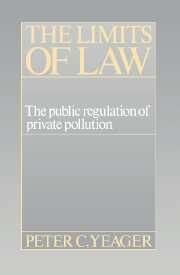Book contents
- Frontmatter
- Contents
- Preface
- Acknowledgments
- 1 The social production of business offenses
- 2 Bringing the law back in: an integrated approach
- 3 The politics of water: pollution policies to 1970
- 4 Contradiction and change: environmental consciousness and the mobilization of law
- 5 Legislating clean water: changing conceptions of environmental rights
- 6 Controls and constraints: from law to regulation
- 7 Enforcement: the social production of environmental offenses
- 8 Ecology, economy, and the evolution of limits
- Bibliography
- Index
7 - Enforcement: the social production of environmental offenses
Published online by Cambridge University Press: 23 May 2010
- Frontmatter
- Contents
- Preface
- Acknowledgments
- 1 The social production of business offenses
- 2 Bringing the law back in: an integrated approach
- 3 The politics of water: pollution policies to 1970
- 4 Contradiction and change: environmental consciousness and the mobilization of law
- 5 Legislating clean water: changing conceptions of environmental rights
- 6 Controls and constraints: from law to regulation
- 7 Enforcement: the social production of environmental offenses
- 8 Ecology, economy, and the evolution of limits
- Bibliography
- Index
Summary
To the public mind, enforcement is the centerpiece of regulation, the visible hand of the state reaching into society to correct wrongs, in social regulation wrongs perpetrated against vulnerable groups and entities. As indicated to this point, of course, the success of any regulatory regime depends on far more than the specific enforcement policies of the state. But both symbolically and practically, enforcement is a capstone, a final indicator of the state's seriousness of purpose and a key determinant of the permeability of the barrier between compliance and lawlessness.
The enforcement process is a deeply textured one. At subsurface levels it is an uncertain mix of the professional ambitions of (usually young) litigators, bureaucratic politics and changing priorities, and virtually constant negotiations with a host of recalcitrants. At its apex is the highly publicized and ballyhooed criminal case, in which egregious violators are demonstrably prosecuted (and often condemned) in the courts of law and public opinion. It is the ultimate expression of the state's power, the power to convict and even incarcerate. It is an expression of large symbolic significance, but there always lurks the danger that it is symbolic only, that it intends to signify much more to the general populace than to the population of the regulated.
In environmental law, as in social regulation generally, it is rarely used. This suggests either that the regulated voluntarily comply in large numbers, rarely necessitating the use of the state's full force, or that effective enforcement has been stunted in some part by various factors in social organization.
- Type
- Chapter
- Information
- The Limits of LawThe Public Regulation of Private Pollution, pp. 251 - 302Publisher: Cambridge University PressPrint publication year: 1991



